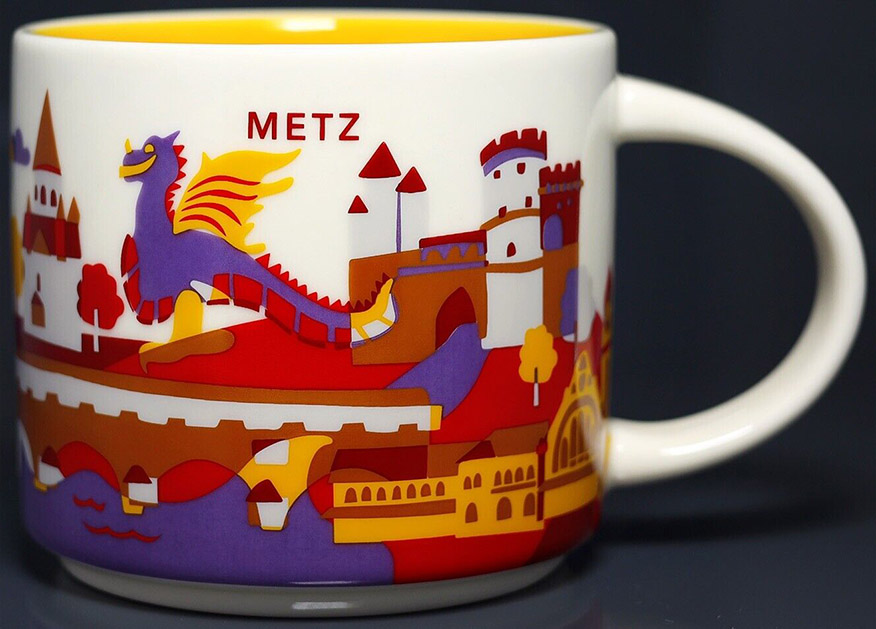
You Are Here – Metz
A beautiful Starbucks You Are Here Metz mug is joining the collection. Nestled in the northeastern corner of France, near the borders of Luxembourg and Germany, Metz is a captivating city that seamlessly weaves together a rich history, diverse culture, and a vibrant modern atmosphere. Approximately 120,000 residents call Metz home, making it a bustling and lively urban center.
The design of the mug features a great choice of colors. I really like how it looks. The front of the mug showcases Graoully Dragon, a legendary creature said to have terrorized the city. The Graoully Dragon is now an iconic symbol of Metz. You can find its statues and depictions throughout the city, including at the Cathédrale Saint Étienne de Metz.
– Speaking of which, Cathédrale Saint Étienne de Metz or Metz Cathedral is a remarkable religious monument dedicated to Saint Stephen. The episcopate seems to be dating back to at least the 4th century, and the construction of the present building began in the early 14th century. Merging with Notre-Dame collegiate church in the mid-14th century, the cathedral gained a new transept and a late Gothic chevet, completed between 1486 and 1520. The cathedral treasury proudly showcases a diverse collection accumulated over centuries, featuring sacred vestments and Eucharist-related items. Remarkably, Metz Cathedral boasts the third-highest nave among French cathedrals (136ft), following those of Amiens and Beauvais. Its moniker, “the Good Lord’s lantern,” reflects its unparalleled expanse of stained glass, spanning a remarkable 70,000 sq. ft. These splendid windows showcase the mastery of artists like Hermann von Münster, Theobald of Lixheim, Valentin Bousch, Charles-Laurent Maréchal, Roger Bissière, Jacques Villon, and Marc Chagall.
– Next to the dragon we can see the Porte des Allemands (the Germans’ Gate). It is a well-preserved medieval gatehouse and fortification. Dating back to the 13th century, this fortress stands as an emblem of Metz’s medieval heritage in its capacity as a City of Art and History. Following its reopening to the public on June 7, 2014, it has become a prestigious venue for numerous cultural gatherings, owing to its imposing presence and grandeur.
– The Opéra-Théâtre de Metz Métropole a.k.a. the Metz Opera, is a 750-seat opera house and theatre which is a testament to neoclassical elegance. It stands as a focal point for the performing arts, hosting a diverse array of opera, theater, ballet, and musical performances. Being the oldest operational opera house in France and among the most ancient in Europe, it also stands as one of the few in France that still maintains its own costume workshops.
– Temple Neuf, (New Temple) is a Protestant church located on Place de la Comédie, adjacent to the Opéra-Théâtre, encircled by the Moselle River. The constructions of this architectural marvel, started on November 25, 1901, during Metz’s tenure under the German Empire. Named the Neue evangelische Kirche at its inauguration on May 14, 1904, the church exudes the charm of Romanesque Revival style. Recognized as a historical monument of France since 1930, Temple Neuf remains a timeless emblem of Metz’s architectural heritage.
– The Imperial Quarter of Metz stands as a distinct district within the city. Constructed mostly between 1902 and 1914 under the German Wilhelmine Empire’s rule, during the annexation of Alsace-Lorraine, it was originally named “Neue Stadt” or “New City.” Presently, it spans the administrative regions of “New Ville” and “Metz-Centre”. At its core lies the “Imperial Triangle,” encompassed by the water tower of the main railway station, St. Therese’s Church, and the Serpenoise Gate. However, the district’s influence extends beyond, encompassing other architectural marvels of the same era, such as the Governor’s Palace situated on Place Giraud, tucked behind the Serpenoise Gate. Standing alongside Strasbourg’s Neustadt, the Imperial Quarter of Metz remains a beacon of the most complete and well-preserved instances of urban design during the German Empire. Unlike comparable districts in Germany, which often bore the brunt of Allied bombardments during World War II, the Imperial Quarter boasts a rich array of architectural styles. This achievement is remarkable considering the city’s voluntary Germanization at the time.
More things to do when in Metz:
– Explore the Old Town: Wander through the narrow cobblestone streets of Metz’s Old Town, where you’ll discover charming shops, local markets, and hidden gems.
– River Cruises: Enjoy a leisurely cruise along the Moselle River, offering picturesque views of the city’s skyline and historic bridges.
– Gastronomic Delights: Indulge in the local cuisine, which is influenced by both French and German traditions. Be sure to try Quiche Lorraine, a savory pastry specialty.





































































